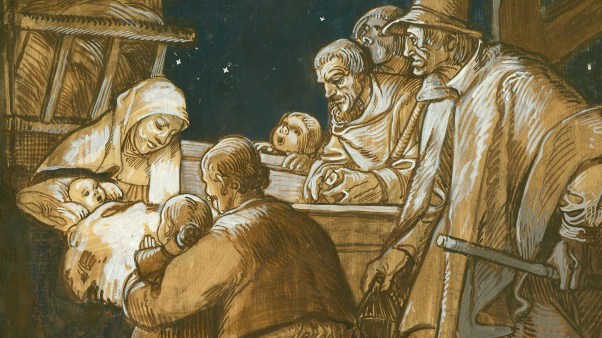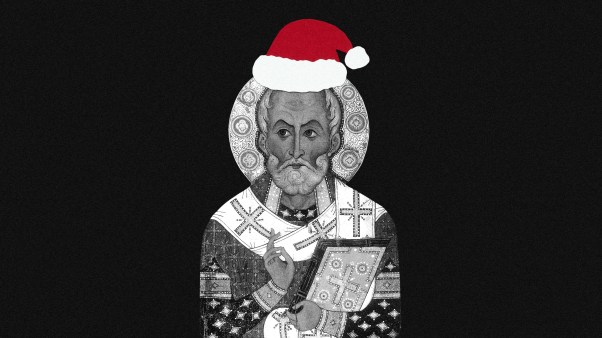“Jesus chose Paul, who was highly educated, for spreading the gospel to the Gentiles. He later raised up Peter Waldo, a successful businessman, to keep His truth alive during the Middle Ages. In these last days WHEN THE GOSPEL MUST GO AROUND THE WORLD, Jesus chose a man amply trained in the advertising and business fields to shoulder the mission—HERBERT W. ARMSTRONG.”1A True History of the True Church, by Herman L. Hoeh, Ambassador College, 1959, p. 26.
Thus is Herbert W. Armstrong presented as a modern Paul divinely appointed to proclaim the Gospel to the ends of the earth before the wrath of God’s judgment is visited upon it.
According to Armstrong, he and the Worldwide Church of God are “merely poor human instruments in the very Work of the Almighty Living God, preparing the WAY! Even now, this Work is changing the lives of thousands every year. Soon, under the world-ruling Government of God, it will finally result in not only CHANGING THE WORLD, but also in SAVING THE WORLD” (The Plain Truth, January, 1969, p. 32).
Armstrong cites seven criteria by which the remnant church, from apostolic times until the present, has been identifiable: (1) observance of the Sabbath on the seventh day of the week, (2) retaining the Passover and other Jewish feasts (while renouncing Christmas, Easter, and other religious holidays of allegedly pagan origin), (3) compliance with Old Testament kosher laws, (4) rejection of the Trinity doctrine in favor of the semi-polytheistic, quasi-pantheistic, God-is-a-family concept, (5) practice of adult baptism by immersion (valid only if administered by a “true minister of the true Church”), (6) non-involvement in secular governments, and (7) use of the designation “Church of God.” Citing twelve New Testament passages in which the phrase “Church of God” appears (and noting that twelve is “God’s complete number”), an Armstrong pamphlet declares, with typically Armstrongian screaming italics and capitalizations,
These verses prove the NAME of the true Church. Denominations not bearing this could not be God’s true church. And of all the churches that do bear the name, only one could be the true Church of God—that one which OBEYS ALL the commandments of God and maintains the FAITH delivered once for all time—the one which grows in truth. All others are counterfeit, even though they may have the knowledge about the true NAME of God’s Church [A True History of the True Church, p. 28].
Herbert W. Armstrong was born in Des Moines, Iowa, in 1892. He describes himself at age sixteen as a precocious youth, obsessed with a desire both for wealth and prominence and for academic learning. “I began frequenting the philosophy, biography, and business administration shelves of the public library,” he says (The Plain Truth, December, 1969, p. 1). He began dating girls a year or two older than himself. But “if a girl could not discuss intelligently the philosophies of Plato, Socrates, Epictetus,” he lost interest. The dates were merely “occasional,” and he usually “spent evenings in study while other young men were seeking pleasures” (The Plain Truth, November, 1969, p. 2). Eschewing a college education in favor of his own program of self-learning, he entered the field of sales and advertising at eighteen.
It was in the fall of 1926 that Armstrong stumbled upon the first of a succession of clues that led to his “Great Enlightenment.” His wife had come under the influence of a woman (a neighbor to his parents in Salem. Oregon) who had convinced her that the God-ordained day of worship is the seventh day. Unable to talk her out of this “religious fanaticism,” Armstrong says that he was literally angered into his “first STUDY of the Bible.” He relates:
I sought, wrote for, and obtained at the public library every book or booklet possible purporting to refute seventh-day Sabbath observance. I searched every nook and cranny of the New Testament to find the sanctification … to observe Sunday. It was like hunting for the needle in the haystack—the needle that isn’t there! Like the pot of gold at the end of the rainbow, I never found it [Tomorrow’s World, June, 1971, p. 2].
On the contrary, he found abundant evidence that “the New Testament commands Sabbath observance.” Convinced of the Bible’s inspiration and authority, Armstrong made an “unconditional surrender” to God. “I told God He could have my life, and if He could make anything out of it, He could have it—I had made only a failure out of it!” To the intense young advertising executive, smarting from his third business failure, surrender meant “GIVING UP everything.” “The change came early in 1927. Almost night-and-day Bible study continued. My wife was miraculously healed.… The first conversions through my preaching came in December 1930. Never had I experienced such joy” (Tomorrow’s World, June, 1971, p. 4). Convinced of the validity of the seventh-day Sabbath, Armstrong identified with the Church of God (Stanberry, Missouri), and was ordained a minister of that body in 1931. However, when the church rejected the bizarre theory of British-Israeliam with which Armstrong had become enamored, he left this organization and began the independent ministry that has since grown into the Worldwide Church of God.
In the summer of 1933 Armstrong planned a series of lectures on the biblical formula for success and prosperity: giving instead of getting. The lectures were given in a one-room country schoolhouse eight miles west of Eugene, Oregon. Average attendance in the tiny, thirty-five-seat building was thirty-six. A larger audience was reached through the 100-watt radio station KORE in Eugene. The initial broadcast was aired during the first week of 1934, and that same month a borrowed mimeograph turned out a free publication entitled The Plain Truth for interested listeners.
Moving to Pasadena, California, Armstrong launched a third vehicle for the dissemination of his gospel in 1947. From its modest beginning (eight faculty members and four students) Ambassador College has expanded to 1,400 students on three campuses. The college at St. Albans, England, opened in 1960; the Big Sandy, Texas, campus in 1964. A current $22 million expansion program is designed to raise enrollment to 2,100 (700 at each location). A correspondence course enrolling “scores of thousands from around the world,” with “additional thousands” beginning every month; a plethora of books and pamphlets, produced at Ambassador’s modern printing plant; a second free quality magazine, Tomorrow’s World, whose October, 1971, circulation is listed as 800,000; expansion of the electronic ministry to more than 300 radio and television stations worldwide; the rise in circulation of The Plain Truth to some 1.5 million; the use of paid advertising in leading magazines; the establishment of thirteen strategically located distribution centers throughout the world; the appointment of “ministers” to cities throughout the United States and in a number of foreign countries; the establishment of churches in local communities (an estimated 200 to date); the holding of regional rallies in major cities—all these have served to transform the original local effort into a globe-encircling operation that the Armstrongs claim, with obvious exaggeration, carries the church’s message into “approximately 150 million homes” (This Is Ambassador College, 1969, p. 60; the exposure of an estimated five million people monthly to The Plain Truth would seem a reasonable index of the movement’s influence). According to figures provided by an Armstrong minister, baptized membership is approximately 70,000, of which 10,000 are overseas converts, including 4,000 in England. Armstrong’s son Garner Ted is associated with him.
What accounts for the tremendous appeal of the Armstrong movement? The dynamic broadcasts? The slick publications? The use of shock and sensationalism? Skillful use of Madison Avenue’s most ingenious devices? There are other factors.
1. In an age of religious apostasy, in which millions of Bible-believing Christians have lost confidence in their denominational leaders and institutions, Herbert W. Armstrong has declared himself and his church to be unequivocally committed to the inspiration and inerrancy of Scripture. He has projected an image of unwavering orthodoxy by affirming the diety, virgin birth, vicarious death, glorification, and pre-millennial return of Jesus Christ.
2. In a day of moral decay and spiritual poverty, Armstrong has scathingly condemned the new morality, biblical illiteracy, the drug menace, divorce, the hippie culture, the militant protest movement, women’s lib, pollution, inflation and other aspects of society today that many feel are warning signs of the demise of civilization.
3. In a time of cynical repudiation of moral values, Armstrong has vigorously affirmed the old-fashioned Christian and American virtues of honor, reverence, patriotism, thrift, integrity, chastity, and temperance. Thus he has gained the sympathy and support of vast numbers of the so-called silent majority.
4. In a period of widespread pessimism and despair, the Armstrong gospel promises a bright, new, beautiful “World Tomorrow,” from which all the evils of contemporary society will be eradicated and in which peace, prosperity, and complete happiness will prevail. The gathering gloom of protracted war (especially the sharpening focus upon Israel as a potential arena of international conflict), intensified poverty and famine, multiplied occurrences of floods and earthquakes, increasing moral degeneration and spiritual nihilism—all these conditions bolster the role of Herbert W. Armstrong as prophet. For years he has warned that these signs would occur just before the avenging battle of Armageddon and the return of Christ to create a perfect new society under his millennial reign.
5. In an era of incessant financial appeals from scores of religious and charitable organizations, it is refreshing to find an operation that appears to be completely non-mercenary. All literature is offered free of charge. No representative will call unless invited. There is absolutely no pressure to contribute or to join. This low-key approach has done much to win public confidence in the Armstrong enterprise.
Space does not permit an extensive discussion of the deviant doctrines of Armstrongian theology. A brief list must suffice.
1. There is only one true Church—the Worldwide Church of God.
2. There is only one true interpreter of Scripture and God-enlightened prophet in these latter days—Herbert W. Armstrong.
3. There is only one acceptable day of worship—the seventh day.
4. There is only one valid means of induction into God’s Kingdom—immersion baptism administered by a minister of the Worldwide Church of God.
5. The Trinity doctrine is heretical. The Holy Spirit is a “divine force” (cf. Jehovah’s Witnesses), an “it” rather than a “he.” With the Mormons, Armstrong believes that God is a family, consisting of the Father, Jesus Christ the Son, and all human beings who become also his sons (and thus equally divine) through spiritual rebirth.
6. The “new birth” has nothing to do with spiritual change in this life. It relates instead to the new life as spirit beings into which God’s children are born through resurrection.
7. The immortality of the soul is a false doctrine. Man does not have a soul—he is a soul. The soul is mortal (Ezekiel 18:4, “The soul that sinneth, it shall die”). Like the Seventh-day Adventists and Jehovah’s Witnesses, Armstrong and his followers believe that man ceases to exist upon death but is recreated in a future resurrection.
8. There will be three resurrections: (1) the resurrection of the faithful, who will reign with Christ in his Jerusalem-based millennial kingdom; (2) the resurrection of “the vast blinded majority, who never really had a chance to accept God’s way of life,” for a 100-year “first chance” (Armstrong denies that this is a “second chance,” since they never in fact had a fair chance during their earthly existence); and (3) the final resurrection, after this 100-year period, when the wicked will be raised, judged, and consigned to destruction in the lake of fire (Rev. 20:13–15). There is no hell. The evil will be annihilated. The only beings destined for eternal punishing (as opposed to the eternal punishment of death) are Satan and his angels.
9. Salvation is not in any sense present; it is future. It is not an act but a process. Justification (acquittal from punishment for past sins) is accomplished by faith. But salvation (ultimate forgiveness and eternal reward) is contingent upon life-long compliance with God’s ritual and moral requirements and therefore cannot be guaranteed ahead of time. The only person to date who has achieved salvation is Jesus Christ. Dubbed “the new Galatianism,” the Armstrong brand of Christianity defines the formula for salvation as faith plus works, as opposed to the Pauline doctrine of salvation through faith alone (with works seen as the inevitable effect, not a determinative cause.
10. The mainstream of conservative biblical scholarship notwithstanding, Scripture passages usually interpreted figuratively must (not should) be taken literally. Two examples:
a. “Peter said that a ‘day’ in God’s plan is as ‘a thousand years,’ and ‘a thousand years’ of human civilization is as one ‘day’ in His planned WEEK of seven 1,000-year ‘days’ (2 Pet. 3:8)” (Ambassador College Correspondence Course, Lesson I, p. 12). Accepting uncritically Ussher’s pinpointing of the Creation at 4004 B.C., Armstrong argues that the first six 1,000-year days are drawing to a close, and the seventh day of “rest” (the millennial sabbath) is about to begin.
b. Choosing to ignore Jesus’ prediction of his resurrection on “the third day” (e.g., Matt. 16:21), Armstrong insists that the “three days and three nights” prefigured by Jonah’s incarceration (Matt. 12:40) be given a literal interpretation. (This, of course, would place the resurrection on the fourth day.) Christ’s entombment was “not one and a half days as the churches today believe, but three! By this teaching of a day and a half, the devil is trying to take our very evidence of a hope for salvation away from us. Christ arose the third day! He was crucified late Wednesday afternoon and arose late Sabbath (Saturday) afternoon” (C. Paul Meredith, “If You Die … Will You Live Again?,” undated reprint, p. 5).
11. In advancing the fanciful delusions of British-Tsraelism, Armstrong assigns to absurd legendary accretions, bolstered by wildly imaginative exegesis of Scripture, the authoritative finality of the Decalogue. The “Lost Ten Tribes of Israel,” following the fall of Samaria in 721 B.C. and the collapse of the Northern Kingdom of Israel, did not lose their identity, as most historians maintain. Rather, they migrated across Europe, leaving traces of their identity along the way. The tribe of Dan, for example, left its calling card in a number of places incorporating the words Dan and Don: Danube, Dnieper, Donegal, Londonderry, Denmark (“Dan’s Mark”). The word British is derived from the Hebrew berith (covenant) and ish (man), so that British means man, or people, of the covenant. (Elimination of the e produces brith. And since the Hebrews, and later the English, drop their h’s, the result is Brit!) The word Saxon is derived from Saac’s Sons, or Isaac’s Sons (“vowels are not used in Hebrew spelling”). By a fantastic flight of fancy, Armstrong alleges that Jeremiah escorted a daughter of Judah’s last king, Zedekiah, to Ireland in 569 B.C. She had married the son of the king of Ireland, who had visited Jerusalem just prior to its fall in 585 (Armstrong’s date). Jeremiah brought with him to Ireland the stone used by Jacob as a pillow on the night of his vision of the heavenly ladder. This stone, insists Armstrong with a straight face, is the Stone of Scone which for centuries has been located in Coronation Chair in Westminster Abbey!
Manasseh, destined “to become the single GREAT nation,” and Ephraim, to become a “company of nations,” are identified as the United States and Britain. “The proof that we are Manasseh is overwhelming. Manasseh was to separate from Ephraim and become the greatest, wealthiest single nation of earth’s history.… Manasseh was, in fact, a thirteenth tribe.… Could it be mere coincidence that [the U. S.] started as a nation, with thirteen colonies?” (The United States and British Commonwealth in Prophecy, by Herbert W. Armstrong, Ambassador College, 1967, p. 126). After attaining great wealth and power, these two tribes will be defeated and destroyed by a restored Holy Roman Empire (the beast of Revelation 17), the ten horns of which will be the ten nations of which ultimately the Common Market will be composed. This united states of Europe, probably headed by Germany, will lay a “yoke of slavery-without-mercy” upon the United States and Britain.
On the surface, the Armstrong cult appears innocuous enough. In fact, most evangelicals would agree that it has much to commend it: its strong position on Scripture; its affirmation of Christ’s deity and his role as Redeemer; its hard-hitting crusade against crime, delinquency, sexual permissiveness, pornography, the drug culture, and other social and moral evils; its theological treatment of national and international affairs.
But sinister dangers lurk behind this deceptive front of solid Middle America conservatism. To adopt the Armstrong variety of Christianity is to renounce all others. To accept Armstrong’s prophetic role is to reject the wise counsel of Christianity’s greatest interpreters—among them Augustine, Luther, Calvin, and Wesley. To believe the Armstrong gospel is to reject virtually all of Christianity’s classic doctrines: the Trinity, the personality of the Holy Spirit, the sinless nature and bodily resurrection of Christ, the immortality of the soul, the new birth as a conversion experience, salvation by faith alone, the existence of hell as a place of eternal punishment. To subscribe to Armstrong’s system of doctrine is to submit to a rigid straitjacket of legalism, biblical literalism, and arcane mythology—to accept a regimentation every bit as restrictive and stultifying as that of Jehovah’s Witnesses.
The Worldwide Church of God amply illustrates the capacity of the half-truth to seduce and ensnare. Attracted by its alluring exterior, persuaded by its smooth eloquence, disarmed by its soft-sell assurances—that the organization is “not denominational,” that its literature is “absolutely free,” that “there is nothing to join”—the unsuspecting church member is gradually brainwashed by the Armstrong propaganda until he at last succumbs. He may begin by sending money, by abandoning Sunday worship and the observance of Christmas and Easter, by seeking the services of an Armstrong minister. Then, at last, he agrees to baptism and full membership in the Worldwide Church of God and obligates himself to pay his total tithe to the organization, to cease voting and otherwise participating in “this world’s government”—in short, to buy the entire Armstrong package.
Thus he commits himself to an eclectic blend of Seventh-day Adventism, Russellism, Mormonism, and British-Israelism, for which he must be willing to forfeit those essential Christian truths and vital spiritual experiences that are the priceless heritage of all who through repentance and faith have come to know the real Jesus of the New Testament as personal Saviour and Lord. But the most disturbing aspect of the Armstrong success story is the fact that millions of professing Christians are so poorly grounded in both Scripture and doctrine that they fail to recognize the fallacies of the gospel according to Armstrong.
Ironically, for all his departures from evangelical truth, Armstrong is biblically, Christologically, and ethically much sounder than are many of the liberal theologians who shape the programs and curricula of most of the mainline denominations. Fully aware of this situation, Armstrong is exploiting the dissatisfaction of millions of disenchanted church members to the very hilt.
The Day After Christmas
The Yuletide went out
And left a beach of colored
Bows half buried—sand-sogged
Remnants of man’s gift to man …
The hint of a carol
Hung somewhere in the damp
Air of the day after—
The ghost of lusty voices
Wafted out to sea
On a strip of yellow lace—
The piece of earth
Willed good by men …
Sequins scattered,
Mingled Jingle Bells
Rung the day before …
And suddenly, what had come
Had gone like the tide,
And man’s soul
Strewn with paper magic,
Lost God’s gift to the sea
And was left on an empty shore.
BARBARA JACOBSON
Joseph Martin Hopkins is associate professor in the Department of Bible and Philosophy at Westminster College, New Wilmington, Pennsylvania, where he received the B.Mus. He also holds the B.Th. (from Pittsburgh-Xenia Seminary) and Ph.D. (University of Pittsburgh).










